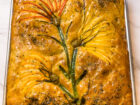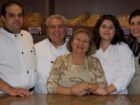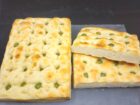
Trends in focaccia
By Karen Barr
Features Business and Operations In the Kitchen Techniques Trends editor pickHow to expand variety and increase sales
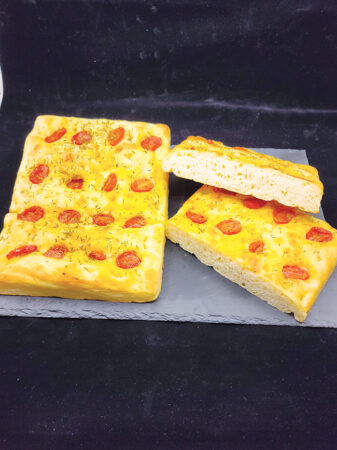 Tomato focaccia is one of three top sellers at La Focacceria Artisan Bakery in Fort Langley, B.C. Photo: La Focacceria Artisan Bakery
Tomato focaccia is one of three top sellers at La Focacceria Artisan Bakery in Fort Langley, B.C. Photo: La Focacceria Artisan Bakery Focaccia is a multi-purpose grab-and-go bread associated with both Italian cuisine and pure comfort. If you are not offering your customers focaccia, it may be time to reconsider. Expanding on varieties while being aware of trends can increase sales.
San Pietro, Montreal
In 1979, Italian-born Pietro Calderone founded San Pietro, a full-service bakery located in Montreal. When he initially arrived from Sicily, he worked in construction during the spring and summer and in bakeries in the fall and winter. Once Pietro felt he had mastered the baking trade, and armed with his grandmother’s bread recipes, he set up a little shop with his wife Carmela. “The key to perfect focaccia is all in the dough!” Pietro says.
Today, San Pietro is a family business, where their son Leo is the master baker and daughter Pina is the cake decorator. The grandkids serve at the front counter.
Pietro’s son Leo learned the art of baking at an early age. “I remember at the age of 12 my dad woke me up at 1 in the morning for the first time. I was really excited to bake because I saw him doing it for so many years. I love the fact that you start with nothing and end up with something amazing.”
When asked about the three top sellers, Pina says, “We make a stuffed focaccia or springioni with potatoes, onion and Italian sausage. The springioni are all made to order. The second is a tomato, olive and artichoke focaccia. The third is a rosemary, pepper and pecorino Romano focaccia.
The focaccia is also used as the base for both pizza and sandwiches. “We make a thick, fresh herb and rosemary focaccia pizza that is staged with mortadella and provolone. Our olive and tomato focaccia, as well as our onion focaccia, is turned into sandwiches using either prosciutto cotto, prosciutto, or any deli meat the customer might prefer.”
Pasticceria Gelateria Italiana, Ottawa
Also in 1979, Joe Calabro was busy opening Pasticceria Gelateria Italiana in Ottawa. About focaccia Calabro says, “It’s not like making bread. The dough needs to be softer, with the right amount of water. I use regular all-purpose flour or sometimes 00 flour. The key to good focaccia is all in the hands. It needs to be the right texture. It needs time to rest.”
Calabro says his customers prefer classic flavours including rosemary and sea salt focaccia, potato slices with onion focaccia or a pesto topping with anchovies. “Another variety that is popular with my customers is the tomato focaccia. We use peeled and sliced San Marzano tomatoes.”
As for social media trends, photo-worthy focaccia “artworks” lean toward garden scenes. Ideas for focaccia bread art include red onions and colourful bell peppers in red and yellow to create petals. Asparagus sprigs make for strong stems, while green peppers or even herbs produce perfect leaves. Think olives and small tomatoes for flower stamens or buds. Savvy bakers can also combine edible flowers and herbs for more realism.
“It’s a fun way to be even more creative with focaccia. Photos add interest to a bakery’s social media such as Instagram, Facebook or Twitter. And customers love it.”
Forno Cultura, Toronto
For Andrea Mastandrea, owner of Forno Cultura, with six bakeries in Toronto, focaccia is a product in constant demand. Mastandrea started the business over a decade ago but apprenticed under the watchful eye of his father and grandfather at the family-owned Aida’s Bakery, founded in 1971. Today, Forno Cultura has 168 workers and two 3,000-square-foot production kitchens.
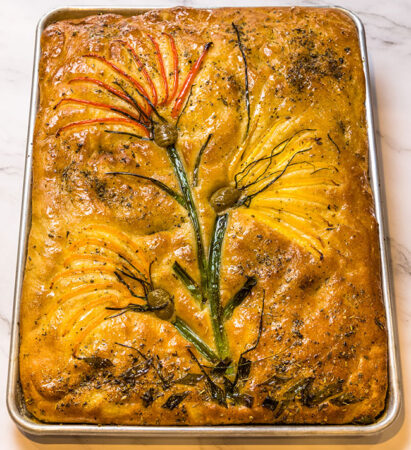
Ideas for focaccia bread art include garden scenes as in this photo-worthy floral by Joe Calabro of Pasticceria Gelateria Italiana in Ottawa. Asparagus sprigs make for strong stems, while green peppers or even herbs produce perfect leaves. PHOTO: SULIMAN CHADIRJI(ri (17)
“We make traditional Barese focaccia with 100 per cent semolina from Altamura, Puglia, with real cooked potatoes and olive oil,” Mastandrea says. Each focaccia is presented traditionally in a 10-inch round.
When asked to name his three top sellers, Mastandrea says, “Classic Barese Focaccia with tomato, oregano, sea salt and olive oil. Next is the olive variety with Cerignola and Peranzana olives that we import from Puglia. It has fresh thyme, oregano, sea salt and olive oil. The third is the potato with fresh rosemary, thyme, oregano, sea salt and olive oil.”
Many customers buy focaccia to take home for snacking or as a basket bread with meals. Forno Cultura also turns its focaccia into sumptuous sandwiches. “We make a wide variety. The Mortadella sandwich is made with in-house pickled giardiniera, provolone, arugula and kale. Another is the prosciutto cotta ham with speck Emmenthal, arugula, and kale. Our Funghi sandwich is made with marinated portobello, cremini and button mushrooms presented with goat cheese, Emmental, arugula and kale. The Melenzana is comprised of grilled eggplant, with fresh zucchini, Emmental, arugula and kale.”
La Focacceria Artisan Bakery, Fort Langley, B.C.
Robert Giardino, owner of La Focacceria Artisan Bakery, in Fort Langley, B.C., opened the shop in late 2019. “We initially offered two regional styles of focaccia, Genovese and Pugliese. After about a year and a half, we now only offer Pugliese style in two dough variations – Barese style and Altamura style – with a variety of savoury toppings in each.”
When it comes to flour, Giardino says, “I exclusively use Italian flour for everything, including cookies and sweets. I select 00 or 0 depending on what is available locally in the strength I need, and finely milled durum semolina.”
Since his shop is in British Columbia, one must wonder if Giardino uses alternative grains. “No. Since I only use Italian flour It’s hard to convince an importer to bring over anything other than what they call pizza flour. So, until I can get local access to Italian alternative grains to experiment with, I am sticking with traditional regional formulations. However, I also utilize a cold, overnight retarding of the dough, to allow the enzymes to break down the complex carbohydrates into a simpler form that our bodies can better metabolize.”
La Focacceria’s three top sellers include two Barese-style dough focaccias: the first a roasted garlic and the second a rosemary. The third is an Altamura-style dough made with Altamura semolina. The favourite here is the tomato. All are produced in large rectangles measuring 7.5 by 10.5 inches. The freshly baked variety is sold whole or in half. Frozen parbaked focaccia is sold whole.
“As my retail customer base, I do have some Italian ex-pats and Italian Canadians as customers, but British Columbia’s ethnic Italian population is nowhere near that of Montreal or Ontario. Most of my customer base is non-Italian. They eat focaccia by dipping it in olive oil and balsamic vinegar.”
Giardino estimates he sells approximately 150 freshly baked pieces and another 40-50 frozen parbaked in his retail shop, which is open four days per week. Additionally, he sells 40-50 frozen parbaked focaccia weekly to wholesale clients.
“We remain a small artisanal retail bakery, just starting to scale up to expand both the wholesale market, as well as additional retail outlets,” Giardino says. The product offering will soon expand the savoury options, as well as introduce sweet focaccia to the lineup.”
Customers love focaccia, from classic to contemporary. And adding to or expanding focaccia menus can lead to increased sales. Why not make focaccia a focus in 2023?
Karen Barr writes about arts, culture and cuisine. She is a graduate of George Brown College and is a Red Seal pastry chef.
Print this page
